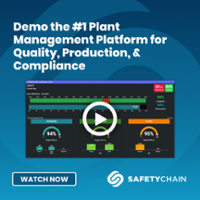The Changing Food Safety Landscape
Food safety has seen a number of recent changes, including increasingly complex supply chains. Since COVID-19, many companies have had to look elsewhere for key ingredients when their routine suppliers were no longer able to meet their demands.
We’ve also seen improvements in epidemiology, which has uncovered new risks. For instance, peaches and onions, which were previously considered low-risk foods, were both linked to salmonella outbreaks this year. Technology has also enabled whole genome sequencing, which can be effective for tracking the original sources of such outbreaks, but puts added pressure on food companies to tighten their food safety measures even further.
Regulatory changes also continue to emerge. While many of the major developments of the Food Safety Modernization Act (FSMA) were unveiled in 2016, the regulatory landscape is an area of continuous change.
Supply Chain Risks
Regardless of where you are in the supply chain, you likely have customers and suppliers. You may have a direct line of sight into the food safety programs of your tier-one suppliers, from whom you purchase ingredients or products directly. Yet, they may not be the ones responsible for managing major risks; it may have to start further back (at the farm, for example). To better mitigate such risks, you need to first know what your risks are, and who is really controlling them throughout the supply chain.
This depends on the ability to track all the information you receive. Companies must implement strategies, including risk-based programs with COAs and reviews of third-party audits, to promote food safety from every link in the supply chain. Controlling these risks must be a team effort, especially because companies find themselves bombarded with paper. Missing just a single COA could introduce risk, which is why supplier management presents an excellent opportunity to leverage technology.
Emerging Threats
Threats are always a source of concern for the food industry. Here are a few drawing the most attention right now:
- Drug and chemical residues
- Heavy metals, including lead and cadmium
- New microbes being found, such as E. coli strains
- New foods being considered high-risk, such as peaches and onions
- Antibiotic resistance challenges
- Allergens
- Food contact surfaces for ready-to-eat (RTE) foods
To mitigate these risks, food safety managers must be constantly looking at their programs. Environments and risks change, and programs must be updated to reflect any new risks that emerge.
Consumer-Related Challenges
When it comes to appealing to consumers, pure science doesn’t always win. For example, consumers have pushed for a shift away from preservatives recently. When these additives are removed from products, however, it introduces new risks. There has also been a demonization of processed foods as the call for clean labels gains momentum, with consumers leaning towards organic, non-GMO, local food. These phases often ebb and flow, and to stay successful, food companies must not only understand and respond to consumer demands but also recognize any risks that consumer-driven changes may introduce.
To add further complexity, consumers typically expect that all food types will be available all the time. Seasonal fruit such as strawberries can be found even without being in season, for instance.
All of these factors can put a strain on food companies, who must pivot and change frequently to accommodate new trends.
Litigation
Litigation is a common concern for U.S.-based companies, more so than food companies located elsewhere. It’s an unfortunate reality that some individuals will go after deep pockets. While some legal action is justifiable, other cases are more difficult to justify.
Strict liability factors put companies at risk no matter where they are in the supply chain. Once again, staying ahead of this concern comes down to knowing where your greatest risks are in the supply chain. Even if you can’t physically control them yourselves, you must watch closely to what’s being done upstream to support mitigation.
Whole-Genome Sequencing
Most Food & Beverage companies are familiar with the “swab-a-thon” where regulators come in and collect samples from various locations in your facility, record the results, and enter them into their database. If at a later point, a strain from an outbreak is linked to your plant, they’ll come back to you for further action.
Recently, there’s been a massive increase in the number of bacteria sequenced — roughly 9,000 a month are added to the database of 500,000 isolates, which is growing constantly. While this allows regulators to link illness outbreaks to their source, the goal moving forward will be not only linking back but also tracing forward to get in front of the curve and stop an ongoing outbreak in its tracks. This brings us to an important topic: product tracking.
Regulatory changes also continue to emerge. While many of the major developments of the Food Safety Modernization Act (FSMA) were unveiled in 2016, the regulatory landscape is an area of continuous change.
Product Tracking
Product tracking allows regulators to find the correct source of a product linked to a foodborne illness quickly. Yet, challenges still exist around information at the point of sale to the consumer. For instance, if a person is sick and gets tested for pathogens such as E. coli, it can take three weeks to get results. Then, officials must piece together information from others who have gotten sick to identify the common denominator.
Conceptually, traceback is simple. From a practical standpoint, however, the process can be tremendously challenging. For fresh foods with short shelf lives, this lengthy process isn’t conducive to preventing illness. For foods with longer shelf lives, the ability to trace back promptly — and trace forward to see where else the products in question have gone — can help remove contaminated food from commerce and control outbreaks. In the future, swiftness will continue to be a priority, which can be supported by airtight supplier management practices.
Beyond the challenges the industry faces, we must also consider how the regulatory landscape is changing and how it will affect Food & Beverage moving forward.
One major area of focus recently has been the FDA’s Food Traceability List. A draft of the regulation has just been published, which updates the language — but not the intent — of the original 2011 document. It’s no longer referred to as the “High-Risk List,” but the foods on it are still known for presenting an elevated risk.
The regulation outlines Key Data Elements and Critical Tracking Events, which were created with the help of industry experts and academics who provided insights on the core elements of a strong food traceability program. While Congress didn’t allow for the FDA to demand full traceability, the one up, one back traceability requirements remain in place.

FDA Inspections
COVID-19 suspended routine inspections in 2020, but these assessments have resumed. The frequency of these inspections is based on risk in your facility, the type of products you produce, and past history of events.
- Domestic facilities deemed to be high risk will be inspected every three years, while low-risk facilities will undergo an inspection every five years.
- Just 2-5% of imported foods are inspected by the FDA, while the USDA inspects 100%. Imported food may also be refused at port, and any events may prompt regulators to place a company on an import alert.
“For Cause” inspections will also continue. These take place when:
- An illness is linked to a product
- A product has been tested and reveals to be contaminated,
- There have been customer complaints which prompt investigation,
- Follow-up for prior observations is required,
- Follow-up to a Reportable Food Registry report for someone else is required, or
- Follow-up to a recall you initiated is required.
As always, it’s important to be prepared for audits at all times.
FSMA
The impact of FSMA continues to permeate the food industry, with the following recent changes taking place:
- The FDA is now using state inspections to assess for compliance with the Produce Rule.
- Imported foods are an increasingly important area of focus and are required to comply with the Foreign Supplier Verification Program.
- Foreign facilities must be fully compliant with FSMA if importing to the U.S. Foreign inspections are risk-based and are currently suspended due to COVID-19 risks.
FDA’s New Era of Food Safety
In their New Era of Smarter Food Safety Blueprint, the FDA emphasized the importance of leveraging technology to establish a safer and more traceable food system. TAG and SafetyChain customers are already checking some of the recommended boxes, using tech-enablement and smarter tools and approaches to achieve supply chain control, enhance quality and safety, trend data, and manage third-party audits, among other initiatives. These forward-thinking companies are using data wisely and sharing it for continual improvement. As data only becomes more voluminous, the ability to turn it into actionable information will help to minimize vulnerabilities.
The Far-Reaching Impact of COVID-19
COVID-19 has affected nearly every aspect of Food & Beverage, but it’s also taught us some fundamental lessons. For one, it’s confirmed the belief that employees are a company’s most important asset. Since the emergence of the pandemic, it’s more important than ever to emphasize employee wellness.
Here are some additional COVID-19 impacts we’ve seen:
- Supply chain disruption
- Economic consequences, especially in restaurants
- Increases in economically motivated adulteration
- Greater use of virtual technology
- Focus on personal hygiene
- Changing messages on best practices from leading resources
One emerging trend from COVID-19 is the use of remote audits and certifications. GFSI certification bodies are now realizing the advantages of no-travel certifications, including reduced costs, which allow savings to be passed on to clients. GFSI guidelines, along with certain schemes, have been updated for some accommodation. While technology is enabling this trend, there are some limits to being fully remote. For this reason, certain audits have required onsite elements.
Through these tumultuous times, companies with innovation initiatives and growth mindsets are faring better than status-quo-driven organizations. Getting fresh perspectives and learning from others can help eager companies embrace change and become more resilient.
Sign Me Up
Join our list to get Industry Webinars Invites, E-Guides, Customer Success Stories, and More.

